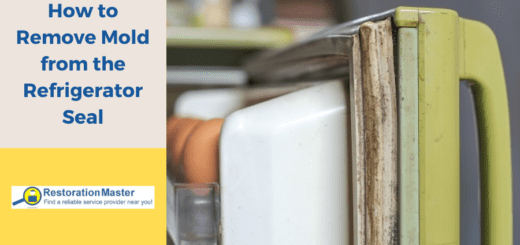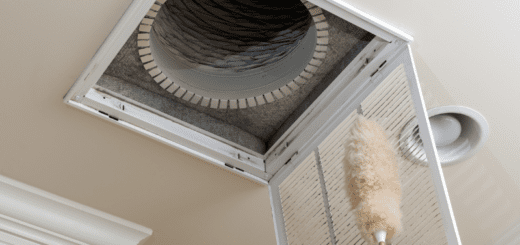“What’s That Smell?” And Other Signs You May Have Mold in Your Home
Mold growth in your home can be a very dangerous and costly issue. Mold is a type of fungi that grows indoors and outdoors and thrives in damp and humid environments. Most of the time mold can be found in bathrooms, drywall, basements, ceilings, carpeting etc. It can also cause significant property damage and exposure to mold leads to a number of health issues.
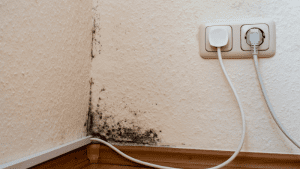
Mold Growth on Baseboard
Why Does Mold Form in Homes?
Homes are easy places for mold to grow. There are many spots in a home that are dark and moist, which is the ideal environment for mold. Due to use of furnaces and water heaters, the temperature in these areas is always similar. Mold spores are always in the air, but once they find a place that works well for them, they start reproducing which causes a mold problem that becomes visible.
Different Types of House Mold
There are many types of molds that are commonly found in homes. Here are a few:
- Cladosporium – Very common type of mold that is greenish-brown or black. Not very harmful unless you have an allergy.
- Penicillium – Also called “green mold,” grows in consistent patches on walls. Some types of this mold can be toxic to humans.
- Aspergillus – It is a greenish-white color, with a raised cloudy appearance. It is not harmful unless you have a week immune system.
- Alternaria – A greenish white color but can appear in black patches as well. Can be harmful to those with asthma and mold allergies.
- Stachybotrys chartarum/Stachybotrys atra (Black Mold) – This is the most dangerous type of mold. Usually black in color and present in water damaged homes. It produces mycotoxins which are harmful and compromise indoor air quality. It also causes stachybotryotoxicosis, which is an infection caused by spore inhalation.
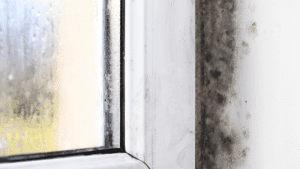
How to Prevent Mold in Your Home
There are some ways that you can prevent mold in your home. Here are a few:
-
Keep your home clean:
Make sure all surfaces are clean, especially those that can be damp such as in bathrooms, kitchens, attics etc.
-
Take care of dampness:
If you have damp areas in your home due to rain or frequent flooding, make sure that you regularly ventilate the home and get rid of any moisture that accumulates.
-
Strive to keep the air dry:
To reduce moisture in the air, use air conditioners and dehumidifiers. Ideally your air should be 40-50% relative humidity to avoid mold growth.
-
Damp areas should be dried out:
Use space heaters or even a hair dryer to dry out any damp areas where mold can grow. Always get rid of the source of dampness, not just the dampness itself.
-
Circulate the air:
You should always ventilate any areas that are prone to mold growth. This includes bathrooms, basements, kitchens, laundry rooms etc. Your home should be properly insulated and ventilated so that the air can circulate well.
Signs You Have Mold in Your Home
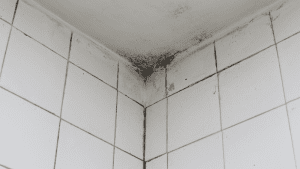
Mold in Shower
There are some signs you need to look out for in your home that will help you identify if you have mold growth. This will allow you to react quickly and contact professionals to remediate it which will limit the damage. You should never try to clean mold yourself as you may spread it further or put your health at risk. Here are some signs of mold to look out for:
- A bothersome cold with allergy like symptoms that won’t go away
- Consistent bloody nose
- Feeling constant fatigue or tiredness and itchiness of the skin
- A musty odor in the home
- Dark spots or warping on the walls
- Tarnished tiles in the bathroom
- A bad smell coming from your air conditioner
- Flooding or water leaks
- Living in a brand-new home
- Condensation on the floor around the water heater area
What to Do if You Have Mold in Your Home
If you suspect that you have mold in your home, you should reach out to professionals right away so that they can remediate it. This will ensure that the mold does not spread further and cause additional damage or possibly become a hazard to your health and the health of your loved ones. You should always look for a company that is experienced, licensed, and specialized in removing mold. A reputable professional will remove the mold and guarantee that it will not come back.
You can expect a mold remediation professional to follow the below steps when working on removing mold from your home or business:
- Inspect the home for any signs of mold, identify the type of mold you have present, and let you know how hazardous it is
- Dry out any moist areas and dehumidify them
- Remove all materials that cannot be restored
- Remove any lingering musty odors that may be left behind after the mold is removed
- Clean and restore your items, restoration may be done on-site or at a separate facility
- Repair the structure of the home or business if needed
If you are ready to have your mold issue handled by professionals, call a mold remediation specialist right away. These professionals will find and remove all mold from your property and restore the damage it caused. They can also address any moisture issues within your home that may have caused the mold growth to prevent it from coming back.










